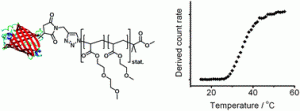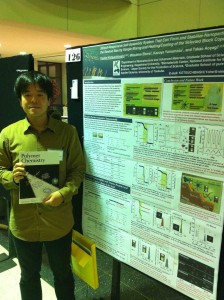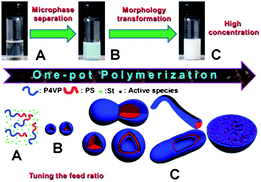Jeroen Cornelissen and co-workers at Radboud University Nijmegen and the University of Twente created a series of thermoresponsive giant biohybrid amphiphiles.
The polymer component was a random copolymer of ethylene glycol methyl ether acrylate and methoxy ethoxy ethyl acrylate formed by atom transfer radical polymerisation. The team linked the hydrophobic polymer to enhanced green fluorescent protein using a copper-catalysed azide–alkyne cycloaddition. Slow heating allows the giant amphiphiles to self-assemble into spherical micelles with a diameter of approximately 60 nm.
Interested to know more? Read the full article for free here: Christine Lavigueur, Jordi González García, Linda Hendriks, Richard Hoogenboom, Jeroen J. L. M. Cornelissen and Roeland J. M. Nolte, Polym. Chem., 2011, DOI:10.1039/C0PY00229A
















![NNCAJWITQ3CA65OY3CCAD7BD1XCAI6NT9ICAW3ZTGSCA6UKW2OCABNZQMDCAULS386CA6FMIXMCAB11870CARE9YIDCA7KR95BCA2FI983CAR2LVGNCAIAGBWUCAOVSEOBCAL2S7RFCAZX9DLKCA272FMF Graphical abstract: Probing cucurbit[8]uril-mediated supramolecular block copolymer assembly in water using diffusion NMR](https://blogs.rsc.org/py/files/2010/10/NNCAJWITQ3CA65OY3CCAD7BD1XCAI6NT9ICAW3ZTGSCA6UKW2OCABNZQMDCAULS386CA6FMIXMCAB11870CARE9YIDCA7KR95BCA2FI983CAR2LVGNCAIAGBWUCAOVSEOBCAL2S7RFCAZX9DLKCA272FMF.gif)


